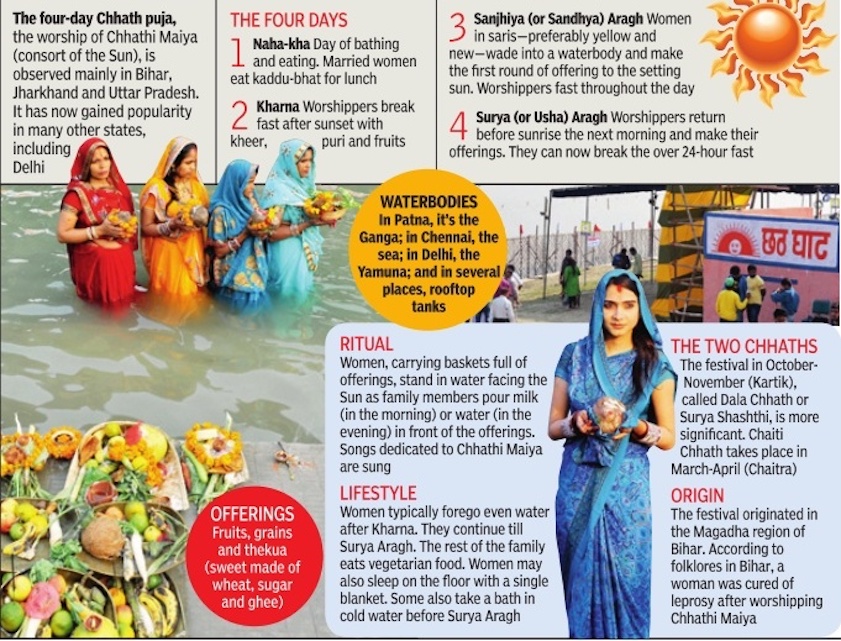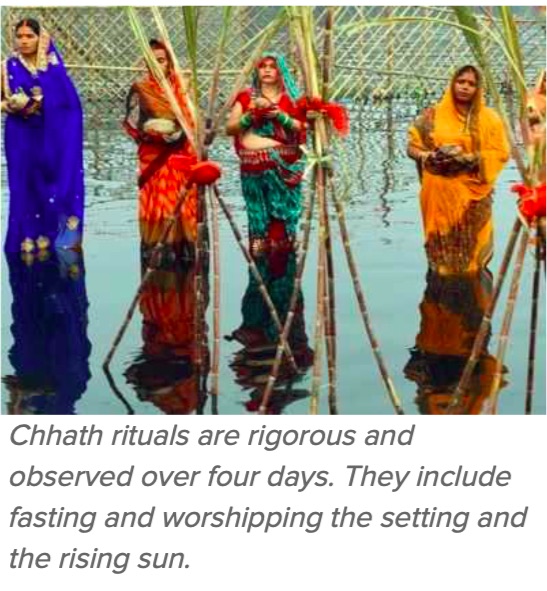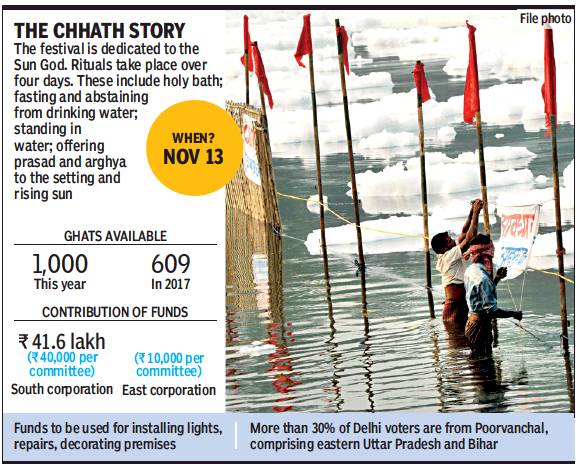Chhath Puja
This is a collection of articles archived for the excellence of their content. |
Contents |
What is Chhath Puja?
Briefly

See graphic:
The annual 4-day Chhath Puja explained.
Details
Yashee, Nov 8, 2024: The Indian Express
What is Chhath puja and why is it celebrated? Which deity is Chhathi maiya? What is it about Chhath that makes it so close to the Bihari heart?
Beliefs behind why Chhath is celebrated
Chhath Puja is a four-day elaborate celebration in honour of the Sun. It involves a long fast without water, and making offerings to Usha and Pratyusha — the light of the rising and the setting Sun respectively — while standing in a water body. The prominent rituals begin from the sixth day (shashthi) of the Kartik shukla paksha, which means the waxing-moon fortnight of the month of Kartik.
Several beliefs are prevalent about why Chhath is observed. Some believe that it is a carryover from the time that man worshipped nature. Others trace its origins in the great epics, the Ramayana and the Mahabharata.
The Rig Veda mentions elaborate rituals to worship the sun. After Lord Ram and Goddess Sita returned victorious to Ayodhya from Lanka, they are said to have observed a fast and conducted a yagna for the Sun god.
In the Mahabharata, when the Pandavas were in exile, some sages visited them. Draupadi, realising she had nothing to offer them, went to sage Dhaumya for help. He advised her to observe a fast and pray to the Sun, and eventually, all her prayers were answered. In the same epic, Karna also organised an elaborate ceremony in honour of Surya (the Sun), his father.
“Both Sita and Draupadi conducted their Sun worship on the Kartik shukla paksha shashthi. Worshipping the Sun on shashthi is considered specially auspicious,” said Dr Ramesh Kumar Upadhyay, president of the Bhartiya Jyotish Aadhyatm parishad in Jamshedpur.
Today, Chhath is a festival that epitomises religiosity in Bihar, and countless devotees, who join their hands as the Sun’s rays spread over them, feel the touch of divinity and devotion in a measure little else brings to them.
While only some people observe the fast, the entire community gets involved in making the festival a success — cleaning river banks and the roads leading up to those banks, gathering all the little things needed for the rituals, and preparing thekuas, the festival prasad which is now synonymous with Bihari cuisine.
How Chhath is celebrated
Chhath Puja is held six days after Diwali (which is on amavasya, or new moon day), in October-November. Some people celebrate it in the month of Chaitra also (in April), which is called the Chaiti Chhath.
Chhathi maiya or Mother Chhathi, Sun’s sister, is considered an exacting but generous deity. While the rules governing the four-day festival are exceedingly strict, immense spiritual gains are said to accrue to whoever observes them all successfully.
“Apart from being Sun’s sister, Chhathi maiya is also the daughter of Rishi Kashyap and Aditi. She is the wife of Kartikeya, Lord Shiva’s son,” said Dr Upadhyay, who has a Phd from Kameshwar Singh Darbhanga Sanskrit University.
The first day of the festival is called naha kha, where those observing it take a meal (khana) only after a ceremonial bath in a river or a pond (nahana). Water brought back from the waterbody is used to make a chulha or stove, and meals for those observing the fast are prepared on this for the rest of the festival. The meal partaken after the bath consists of a bottle gourd sabzi. Over the years, those who can’t go to a waterbody have started observing all the rituals at home.
The second day is called kharna, on which the one observing the fast takes only one meal in the evening, of roti and kheer (rice pudding). This is also the day friends and family gather to prepare thekuas, which are essentially flour cakes with sugar or jaggery fried in ghee. The thekuas, also called khajoor, are prepared taking great precautions to make sure they are perfect for the deity. People can have them only after they have been offered to God.
After the roti-kheer meal begins a 36-hour fast, during which devotees don’t even drink water.
On the third day, devotees go to the banks of a water body. Those who can’t, build a temporary pool in their homes. The banks are decorated with diyas, rangoli, and sugarcane stalks. All the offerings to the gods — seasonal fruits like sweet potato, water chestnuts, pomelo, banana — are placed in soops (cane baskets) along with diyas.
As the Sun sets, the person fasting raises the soop to it as an offering (arghya). Friends and family members of the one fasting pour milk or water on the soop. This is called the Sanjh ka Arghya, or the evening offering. The next day, the same ritual is conducted at dawn, for the rising Sun, called the Bhor ka Arghya, and the community returns home from the riverbanks, grateful for the successful conclusion of a difficult festival and for having taken part in it.
In South India too, specially in Tamil Nadu, Skanda Shasthi is observed around this period, where Lord Kartikeya and his wives are worshipped.
What makes Chhath unique
There are many reasons that Chhath has such a special place in Purvanchalis’ heart. This festival means the coming together of the community, the legendary Bihari migrants returning home to soak themselves in their culture and homeland once more.
People from any caste can observe the festival. There are no priests involved, it is the devotee directly fasting for and praying to a visible, apparent God, who shines on everyone equally. The offerings made to the deity are of seasonal, locally produced and thus easily accessible fruit. No matter how rich or poor you are, the rules are the same for everyone, and the success of the festival lies in how faithfully you observe the rules, not on what scale you observe them at.
Last, and most important, is the message behind the festival — that everyone is equal in the eyes of God, that nature sustains us and is worth honouring, and that dusk is as important as dawn, because life is cyclical and what sets can, and will, rise again.
History, evolution
Delhi’s demographic change and Chhath

From: Avijit Ghosh, Sun shines on fest of migrants: How politics has made Chhath Delhi’s own, November 14, 2018: The Times of India
The Yamuna bank swarms with a multitude of people and colours. A red carpet and smiling posters of Arvind Kejriwal and Manoj Tiwari welcome the worshipper on the path leading to the spruced-up ghats. Inside, a real estate group offers special discount on Chhath booking. Fasting women knee-deep in water pray to the Sun. Earthen lamps spread light and cheer on a cloudy afternoon. On the adjacent Vikas Marg, there’s a small traffic jam.
It wasn’t always like this. Two decades ago, Chhath Puja in Delhi was a low-key affair, hardly the spectacle of today. Politicians did not wish devotees in posters. In many cases, the users cleaned the ghats themselves.
Then, as rising migrant population altered the demographics of the national capital, its politics changed too. In 2003, Delhi had only three ‘Poorvanchali’ MLAs. The current assembly has at least 15 MLAs from Bihar and eastern Uttar Pradesh. Delhi has an estimated 40 lakh migrants from these parts who also form the bulk of devotees. Since 2014, Chhath has been declared a public holiday by the state government.
A report released by the Delhi government this July says the administration spent Rs 6.30 crore on constructing Chhath Puja ghats in 2017. The anticipated cost for 2018 was estimated at Rs 16.18 crore. The Delhi government claims to have set up ghats in around 1,000 locations this year.
Chhath rituals are rigorous and observed over four days. They include fasting and worshipping the setting and the rising Sun. Some devotees prostrate every step on their way to the ghat. Environmentalists have pointed out that Chhath is an eco-friendly festival because no idols are immersed.
The Yamuna bank, among the largest gatherings of worshippers, is bedecked in an orange and white shamiana. Wicker baskets loaded with fruits and other offerings repose by their side. The shimmery sari is the preferred dress of the day. Everyone’s taking selfies, that great egalitarian expression of self-love nowadays.
Suddenly, someone carrying a child rushes to the stage set up for an evening musical show. “I found this girl,” says the Good Samaritan. She is crying. An announcement is made. “Tamanna, a girl in yellow jacket and red frock has been found.” Within five minutes, the mother comes rushing, apologetic.
The main performers of the evening are two Bhojpuri folk singers, Deepak Tripathi and Sanjoli Pandey. “Isn’t Manoj Tiwari coming?” someone asks. “He might. But does he have time for a full musical performance?” counters one of the organisers. The speakers spring to life but the words get drowned in the booming bass.
The cops are everywhere. A couple of them even patrol the river in a motor boat. Another two stand on a raised structure set up on a landmass in the middle of the river. They have the loneliest job of the evening.
As the dusk sets in, the lights from the ghat on the other side of the river gleam like an underwater mall. On Vikas Marg, the traffic tailback grows longer.
Goa
2018
Drishti’s stops cleaning Goa’s beaches, government in a fix, November 14, 2018: The Times of India

From: November 14, 2018: The Times of India
Drishti Lifesaving has stopped beach cleaning services from Tuesday, a move that could leave the beaches dirty if no arrangement is put in place within the next two days. The agency had given prior notice.
Tourism minister Manohar Azgaonkar said the government has requested Drishti to continue for another month and a half. He told TOI that the tender for beach cleaning has been floated and scrutiny is under way. “Drishti has been asked to continue till a new agency is decided on,” he said.
Earlier on Tuesday, Drishti said that its beach cleaning service agreement ended at sunset on November 12 (Monday) and that they had informed the government several days ago. “We have received no further intimation from the department in this matter,” an official said on Tuesday.
“We learnt that Drishti did not qualify to bid for the new beach cleaning tender due to the technical specifications. It’s unfortunate that Drishti is unable to bid despite the efficient service offered over the last two years,” a Drishti representative said.
Drishti was appointed as a stop gap arrangement in December 2016 after the government had discontinued the services of Mumbai-based contractors – Ram Cleaners and Developers Private Limited and Bhumika Clear Tech Services.
The beach cleaning tender was floated in October this year, inviting bids for comprehensive cleaning services of various beaches in the state for five year, almost two years after Drishti was given temporary charge of the exercise.
Administrative arrangements
Delhi
2018
This Chhath, devotees will have 1,000 ghats to pray at, November 10, 2018: The Times of India

From: This Chhath, devotees will have 1,000 ghats to pray at, November 10, 2018: The Times of India
Delhi Government Says People Won’t Have To Travel For Long Distances
To ensure that people do not have to travel long distances to perform Chhath Puja in 2018, Delhi government has set up 1,000 ghats, both permanent and temporary, across the capital.
Delhi Tirth Yatra Vikas Samiti chairman Kamal Bansal said that last year the government had identified 609 locations for people to perform Chhath Puja. “This time, we have increased the number of ghats to 1,000. Devotees will not have to travel more than 1-2km this year to find a ghat to offer prayers,” he added.
Apart from the Yamuna banks, ghats have also been set up near several waterbodies. Also, ponds have been developed in parks owned by the three corporations, public works department and DDA. “The government is making all necessary arrangements, including tents, lights, and chairs where devotees can rest. The ghats along the river and waterbodies have also been cleaned,” Bansal said.
Development minister Gopal Rai on Friday inspected the Hathi Ghat near ITO to see the preparations made by the agencies concerned. He was accompanied by officials of the revenue and irrigation and flood control departments.
Rai said when Aam Aadmi Party formed the government in Delhi, there were only 60 ghats for lakhs of Poorvanchalis to offer prayers. “We have now ensured there are enough ghats for people to offer prayers. Adequate arrangements have been made to provide devotees a safe environment,” he added in a statement.
There are around 40 lakh Poorvanchali voters, natives of eastern Uttar Pradesh and Bihar, who play a key role in elections in Delhi. The South Delhi Municipal Corporation (SDMC) has released Rs 41.6 lakh for providing additional facilities at Chhath ghats situated under its 104 wards in south and west Delhi areas.
Mayor of the civic body Narender Chawla said that each organising committee will be provided Rs 40,000 for this purpose.
“The funds can be used for lighting the streets in and around the ghats, maintenance and related work,” Chawla said. All three civic bodies are also going to set up special coordination booths for this purpose.
Mayor of east and south corporations have written to the chief ministers of neighbouring states to improve water coming from Hindon and Munak canal. Former mayor Preety Agarwal said that Munak canal comes from Karnal to areas like Bawana, Rohini and Haiderpur before meeting Yamuna. “The canal is being cleaned up. The depth of the canal has increased which may cause problems for Chhath devotees. Around two lakh devotees can use this,” she added.
Despite being in tough financial position, cash-strapped east corporation had, announced that it will provide a support of Rs10,000 to every Chhath samiti for carrying out minor works. Mostly celebrated by Purvanchali community this is the only festival which gets financial support from corporations. With more than 30% voters in Delhi from Purvanchal, the migrant population comprising people from eastern Uttar Pradesh and Bihar is a huge vote bank no political party can afford to ignore — especially with the Lok Sabha elections less than 6 months away.
Meanwhile, mayors and top political functionaries of the corporations have started taking rounds of the ghats around the city.